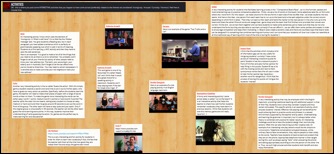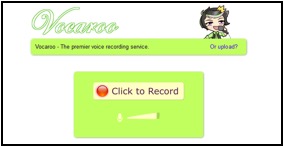
The promise of technology: I firmly believe that technology can radically transform not only the way we teach (traditional teaching with the teacher in control is on the way out) but rather the way our students learn. I am particularly interested in Psychology and I find myself marveling at how potent web tools can be in utilizing some basic principles for helping students learn more effectively and (crucially) for increasing motivation.
- Control: As Langer has demonstrated (e.g. Langer & Rodin 1976), people have the need to feel in control of what is happening in their lives. The more they do, the more efficient they are and the happier they feel. Technology can help students take control of their own learning. For instance, there are many sites (e.g. Breaking News English) where students can select the level of difficulty of the texts/exercises they would like to attempt. Then there are other sites where students start answering questions at varying levels with the software gradually adjusting the level of difficulty to one the learners are comfortable with (as happens with the TOEFL test for instance).
- Commitment: Numerous studies (e.g. Freedman & Fraser 1966) have shown that the strongest predictor of one’s future actions are what these people have done in the past. Let me rephrase this: if we can get learners to take small, active steps towards improving their English, this could have a huge impact in how much progress they make, as it changes their perception of themselves. Technology can help us introduce our students to ‘Strategies’ – little things that they can do on their own, thus changing their self-image (‘I am an active learner!’). Tools like Coggle where students organize their vocabulary in a small network are a good example of this.
- Routines: One of the problems with getting students to do things is that tasks often require a lot of will-power and students get depleted quite easily. If you ask them to write a paragraph, they will procrastinate; if they have to write an essay they may well give up half-way. Technology can offer them the chance of doing the same little thing every day, so that it becomes a routine. Routines do not deplete us because they have become automatic (Baumeister & Tierney 2012 – p. 93). Strategies are the key once again: for instance, singing along to one of your favourite songs in Lyrics Training is not depleting; doing a little crossword on ESLYes every day can become something our students do while they are having their morning coffee.
- Increased participation: Another problem teachers face in traditional classrooms, especially where students are asked to work in groups is ‘social loafing’ – the tendency of people to do little when they are in a team as it is the team that gets evaluated as a whole (e.g. Latane et al, 1979). One of the great things about some of the tools at our disposal today is that they make the students’ contribution visible. Wall applications like Padlet or backchannel chat platforms like Todaysmeet ensure that everybody in class can see who does/says what. What is more, beyond a certain point, the Social Proof principle kicks in (Cialdini 2001 – ch. 4); seeing that many of their peers have actually done something creates huge pressure on the rest to conform – even if they were not all that keen to begin with!

- Sociality: We may think that in the classroom what mattes to our learners is how much they learn, but in fact this is wrong. What matters to them is their peers. Indeed, our relations with one another is what matters above all else to all of us – so much so, that the only brain network which stays active ‘by default’ when we are doing absolutely nothing is the one that deals with social relations (Lieberman 2013 – p. 13). The moral here is clear: the more we can increase the level of interaction between the students in our classes, the more motivated they will be. Todaysmeet is again the first tool that comes to mind, but other tools like Tricider for instance which allows students to comment on what each one is saying, or platforms like Edmodo (designed as it is with an interface similar to Facebook) are also good examples of this.
- The IKEA Effect: One of the most demotivating things about the traditional classroom is the way in which students work endlessly without actually producing anything that they can take pride in. Filling in gaps and transforming sentences cannot generate the sense of fulfillment that creating something does. Ariely has demonstrated that this feeling of creation can be hugely motivating and that it can be triggered even if our contribution is relatively small (e.g. Norton et al 2010). With new web tools students can very easily create something recognizably their own which they can really feel proud of. From simple mini ‘movie clips’ using Dvolver to animations with GoAnimate, to annotated pictures with Thinglink – the possibilities are endless!

- Meaning: Ariely has explored this issue further (Ariely et al 2010). Part of the pleasure we derive from what we create is the process of making it but another, very significant part is sharing our creation with others. As students see it, there is no point in writing a very creative essay or story when the teacher is the only one who is going to look at it. One of the great things about technology however, is that it offers a host of sharing possibilities; students can act out a dialogue and share it on YouTube, they can create a blog and upload their work there, or the class can even have a Facebook page where their latest animation can be displayed for the benefit not only of other classmates, but of the students’ parents and friends.
What is it that teachers need?: Switching to colleagues now, obviously we cannot talk about the needs of the Greek teachers as if they were a uniform group. There are IT experts who help to design ELT-relevant sites and there are people who have never even considered using anything beyond the coursebook in class. Having said that, I think it would be fair to say that the vast majority of colleagues both in the private and in the state sector are a long way from being like the former. It is clear that we need to start with very few assumptions about what people already know. In view of this, I would argue that there are 4 things we need to keep in mind:
- Technology has to be simple: One of the problems with some technology talks/workshops is that the tools presented are far too complex for the average member of the audience. The problem is the ‘Curse of Expertise’ (e.g. Hinds 1999). When technology experts talk about their subjects they assume that listeners can follow them, but very often they simply switch off. The interface can be crucial here; anybody can see how to use ForBetterEnglish at a glance – you just enter the word you want to check in the space provided! Learning how to make sense of the Adobe classroom interface however, might well appear intimidating.

- The time to language ratio has to be low: Sometimes technology advocates get so dazzled by the technical sophistication of a tool they have discovered, that they fail to see it may be of little relevance to language teaching. The problem here is cost-effectiveness; if students need to spend half an hour preparing two frames in a cartoon application for instance just so that they can write three bubbles of dialogue, this is simply bad classroom economics.
- We need input on methodology too: Another failing of many workshops / posts / screencasts is that the experts often give us all the information about how to use a particular tool, but very little about what we can use it for. Yet this is the most important part. For instance, it is clear that students can use Storybird to create their own story; what is not immediately obvious is that another student can be invited to continue the same story, so that something that looks like boring H/W is automatically transformed into an exciting collaborative task.
- Technology needs to be integrated: All too often technology workshops consist of the presentation of a series of tools, along with explanations on how they can be used and possible classroom applications (if one is lucky!). Yet there is still another question to be addressed: where exactly in the lesson does that tool come in? An expert teacher might automatically see that Wordclouds for instance can be used as a warm up pre-Reading activity, but we cannot just assume that everyone will immediately see the usefulness of this application for this part of the lesson.

The importance of fluency: One more thing. After countless workshops and webinars on technology, the rate of uptake is not quite what one might have expected. Why? I think this is partly because of a factor known in Psychology as ‘fluency’ – meaning not fast and effortless speaking, but rather ‘ease of processing’. Psychologists have discovered that if we find something hard to imagine, our brain jumps to the conclusion that it will not happen! (Kenrick et al 2012 – p. 43) So, if you are a tech enthusiast, start small, start easy and look at the interface. Speaking of interface, look at the picture above and put yourself in a novice’s shoes. Can you imagine yourself using this? Now look at the picture below. That’s more like it…

References
- Ariely, D. Kamenica, E. & Prelec, D. (2008) “Man’s Search for Meaning: The Case of Legos” Journal of Economic Behavior and Organization 67, nos 3-4 (671-677)
- Baumeister, R. & Tierney, J. “Willpower” Allen Lane 2012
- Cialdini, R. “Influence – Science and Practice”, Allyn & Bacon 2001
- Freedman J. L. & Fraser S. C. (1966) ‘Compliance without pressure: the foot-in-the-door technique’ Journal of Personality and Social Psychology 4, 195-202
- Hinds, P. J. (1999) “The Curse of Expertise: The Effects of Expertise and Debiasing Methods on Predictions of Novice Performance” Journal of Experimental Psychology. Vol. 5 Issue 2, p. 205
- Langer EJ, Rodin J. (1976) “The effects of choice and enhanced personal responsibility for the aged: a field experiment in an institutional setting.” Journal of Personality and Social Psychology. Aug;34(2):191-198
- Latane, B., Williams, K., & Harkins, S., (1979) “Many Hands Make Light The Work: The Causes and Consequences of Social Loafing”, Journal of Personality and Social Psychology 37, 822-832
- Lieberman, M. “Social” Oxford 2013
- Kenrick, Goldstein & Braver “Six Degrees of Social Influence” Oxford 2012
- Norton, M., Mochon, D. & Ariely, D. (2010) “The IKEA Effect: When Labour Leads to Love” manuscript, Harvard
Bio: Nick Michelioudakis (B. Econ., Dip. RSA, MSc [TEFL]) is an Academic
Consultant with London Exams Hellas. In his long career in ELT he has
worked as a teacher, examiner and trainer. Articles of his have been
published in numerous countries. He is a regular presenter at events for
teachers of both the private and the state sector while he also runs short
courses at the University of Athens. He is particularly interested in
student motivation as well as Social and Evolutionary Psychology. To see
more of his work, you can visit his blog (www.michelioudakis.org)
linguaglobe.com




